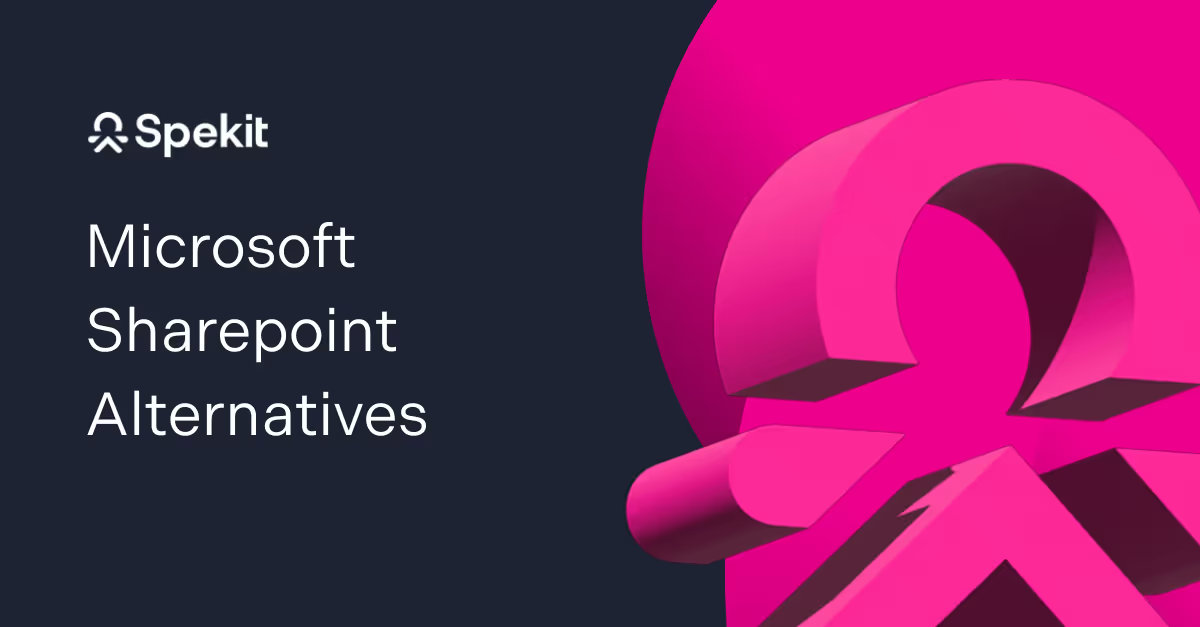According to recent statistics, salespeople spend less than 30% of their work hours actually selling. In fact, they spend almost 20% of their time creating new sales content or searching for an old one.
Fortunately, platforms like Microsoft SharePoint help salespeople manage their content.
But is MicroSoft SharePoint the best for your sales collateral management?
SharePoint is a content repository that stores digital content in files and folders with little call-up support. This means that sales teams relying on these platforms must leave the platforms they are working in to manually find the content they need
In this review, we’ll explore Microsoft SharePoint's features and also highlight the top alternatives to Microsoft SharePoint.
What does Microsoft SharePoint do?
Microsoft SharePoint offers file storage, sharing, and content management with offline viewing and editing on Mac OS or any PC.
As a Microsoft product, SharePoint integrates with other Microsoft product suites, leveraging the features of other apps. For example, SharePoint and Microsoft Outlook integration would allow users to automate emails to notify team members when a new file is added or updated in Outlook.
Microsoft SharePoint vs Microsoft OneDrive
SharePoint and OneDrive are Microsoft products for collaborative document storage and management.
OneDrive focuses on simplicity in delivering file storage and sharing features. Its usage is straightforward, but the capabilities are limited, so it works best for personal file storage or small teams. If you want a shared storage repository for an entire organization, then OneDrive will fall short.
SharePoint is designed for more complex content management. It has more features and allows for collaboration across collaborative platforms. But both SharePoint and OneDrive have little call-up support and sales teams relying on these platforms must manually find the content they need when they need them. A solution like Spekit's SharePoint integration helps streamline content accessibility by surfacing the right information within the tools sales reps already use.
Microsoft Sharepoint Review

Here’s a quick review of Microsoft SharePoint’s features, pros and cons, focusing on how it supports sales teams and sales performance.
Microsoft Sharepoint Features
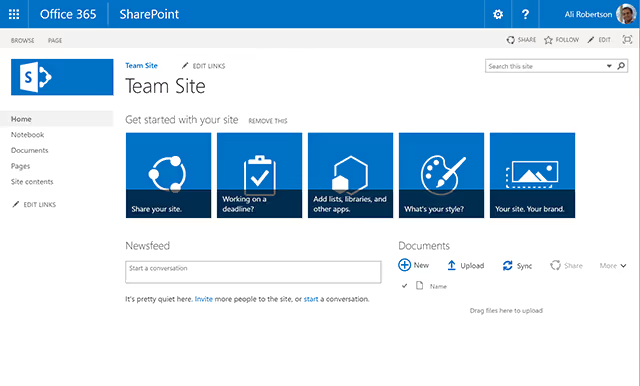
- Customizable team sites: Streamline teamwork by collaborating with team members on team sites virtually on PCs, Macs, and mobile devices
- Home pages and portals: Sharepoint offers an intranet where you can share news updates and common resources with home sites and portals
- SharePoint lists and libraries: Create complex operational workflows from simple sites with SharePoint lists and libraries
- Search functionality: Discover information and insight with SharePoint’s search feature
- Integrations: Integrate with other Microsoft applications from Viva to Power Automate and Power apps
Microsoft Sharepoint Pros and Cons
Some of the benefits users enjoy from using SharePoint are:
- SharePoint has a mobile application for easy user access and flexible document management.
- Users can create complex operational workflows with SharePoint
- Seamless integration with Microsoft 365 product suite
However, based on SharePoint user reviews on G2, an independent app review website, there are some limitations of SharePoint, which include:
- Complex user interface
- Users have to tag and organize their content on SharePoint manually
- Ineffective for sales teams
- Some users experience difficulties when sharing information with people outside their organization
- Users still have to leave the apps they're working in to search for the documents they need on SharePoint
Sharepoint Reviews
According to user reviews on G2, an independent app review site, SharePoint users are impressed by its collaborative features and secure cloud storage. They also enjoy the accessibility and ease of finding information with SharePoint.
However, some users feel it is not user-friendly and can be unnecessarily confusing. Also, some users experience difficulty sharing files with people outside their organization, which may be a drawback for sales reps who mostly share collateral with prospects and buyers outside their organization.
The Bottom Line on Sharepoint
SharePoint can be a good option platform if you only want to securely store and share information across teams and maybe create portals and news sites for specific projects.
However, the Microsoft Sharepoint platform is more of a content repository than a Sales enablement platform, as sales teams still have to dig through multiple files and folders on SharePoint to find the content they need. Also, SharePoint doesn’t automatically tag and organize files once uploaded, so users have to manually tag files, which still takes extra time that salespeople could spend on actual selling.
Microsoft Sharepoint Alternatives
Let’s take a look at some Microsoft SharePoint alternatives for sales teams.
1. Spekit

Spekit is the leading modern sales enablement software built to meet the needs of today's fast-paced sales teams. Spekit's unified platform solves for sales content management, knowledge and enablement, change management, employee onboarding & training, and more.
Spekit differs from traditional enablement platforms like Microsoft Sharepoint by offering a just-in-time enablement solution that combines a personalized rep experience with a scalable content platform. Spekit CMS offers a more intuitive, contextual user experience, focusing on content access and delivery, and is less expensive than Microsoft Sharepoint. Sharepoint can be extremely complicated for admins and end users, difficult to search and manage.
Read here to learn how one customer switched from an existing CMS like Microsoft Sharepoint to Spekit to solve their CMS needs and achieved 90% faster content discovery by reps.
Spekit delivers contextual, personalized enablement assistance through AI Sidekick, providing resources within CRM, email, and Slack. AI Sidekick captures context signals to understand a rep's activity. For example, it analyzes email content or call scripts to prep for the next call. Unlike traditional platforms, Spekit integrates directly into reps’ workflows, providing quick access to training and enablement resources within tools like Salesforce and LinkedIn. Through automated sales content management, Spekit provides direct and quick access to sales materials, eliminating the need to spend hours searching for information. Enablement teams can surface the exact playbooks, processes, sales content, messaging, and collateral sales reps need to close pipeline - exactly when and where they're needed.

Spekit’s robust native integrations extend beyond applications available in Chrome, enabling users to connect to CRMs, enterprise SSOs, and other sales productivity and communication tools. Businesses that use Spekit can boast of achieving 20% higher quota attainment, 69% more time spent on selling, and 30% faster ramp time.
Spekit Key Sales Enablement Platform Features:
- Content Management Repository / Knowledge base: File storage, file syncing, custom fields, tags
- Content integrations: Real-time content syncing GoogleDrive, Sharepoint, Confluence
- In-the-flow of work extensions: Google Chrome Extension, Microsoft edge extension, Slack, Outlook ensure enablement is delivered where your reps are working
- SSO integrations and support: Okta, Azure, Ping Identity and more
- Governance features: Governance dashboard and reporting, version control, roles, content access permissions
- Trackable links: track buyer’s engagement with sales content using unique shareable links that alert sellers when a buyer engages with content
- Deal Rooms: Deal rooms create a centralized hub for buyers and sellers to collaborate, access key content, and accelerate deals with personalized, trackable resources.
ProTip: Any sales enablement platform you should select should at a minimum have the above functionality. Get a more in-depth overview of these features and how to choose what's best for your business by scrolling to the bottom of this post.
Key Unique Capabilities:
- Browser extension: Embed and surface resources for sales reps across any tool using the Chrome extension
- Embedded in-app guidance (Speks): Use Speks to create easily digestible sales content, training, and guides that reps can access in their workflow and embed with tool tips
- Spotlights: Alert reps of new sales or training content and time-sensitive updates using Spotlights to communicate important announcements and send reminders on tasks to be completed
- Just-in-time Knowledge checks: Assess the retention rates and effectiveness of sales training/coaching with short bite-sized quizzes
Spekit Key AI Features:
- AI Sidekick: the rep's just in time enablement assistant
- Context-aware intelligence layer: Spekit's proprietary context-aware intelligence layer delivers just-in-time, relevant content and guidance within the flow of work.
- AI Chatbot: Reps can chat with AI Sidekick to get answers, draft personalized emails, find the perfect content and more.
- Contextual, deal-driven AI content recommendations: Don't guess, use AI Sidekick next to any email, call or Salesforce Opportunity to get the exact content , training, deal rooms, and knowledge recommended to you automatically.
- Spekit AI Editor: Achieve rapid content authoring, summarize lengthy documents, and translate sales content into multiple languages with Spekit AI. When the content sales reps need is not readily available, Spekit AI enables you to whip up content within minutes. It is powered by generative artificial intelligence and is a content assistant for creating playbooks, tool training, SOPs, persona guides, and objection-handling documents. With Spekit AI, your sales content practically writes itself!
- Automated AI Deduping: Automatically identifies duplicate content
Spekit vs. Microsoft Sharepoint: A Head-to-Head Comparison
Ease of Use
- Spekit: Teams can begin using it immediately. It fits naturally into the tools and routines they already rely on, allowing them to stay focused on selling—not figuring out new software.
- Microsoft Sharepoint: Its suite of training, content management, and analytics tools requires careful setup and dedicated oversight. Many teams report needing significant admin time just to maintain basic usability.
Content Management
- Spekit: Spekit acts as your central hub for all sales enablement content. Updating, organizing, and managing your decks, battlecards, and messaging is fast, and changes are instantly visible right where people work. This keeps reps aligned and eliminates "where's the latest deck?" moments.
- Microsoft Sharepoint: Offers advanced content control, but edits often live behind publishing queues or layered approval processes.
Integration & Connectivity
- Spekit: Either replaces or seamlessly pulls content from tools like Google Drive, SharePoint, and Confluence. This consolidates your resources into one intelligent platform, meaning less friction getting started and fewer support tickets later. It also connects instantly with everyday tools like Salesforce, Gmail, and Gong.
- Microsoft Sharepoint: While it integrates with major platforms like Microsoft and Salesforce, the setup often requires upfront technical effort and ongoing coordination.
Training and Onboarding
- Spekit: Training happens naturally—right as sales reps are doing the task. For example, when a rep hovers over a field in Salesforce, a Spekit tooltip might appear explaining what to enter and why it matters. This kind of contextual guidance helps reps learn without interrupting their flow. No need to send reps off to portals or chase LMS completions.
- Microsoft Sharepoint: Provides formal training infrastructure. Useful for scheduled programs, but less ideal for on-the-fly support in fast-moving environments.
3 AI Sidekick Features You Can’t (or aren't as smooth) in Microsoft Sharepoint
Sometimes the differences come down to what you can actually do day-to-day. Here are a few features Spekit users rely on that aren't available—or aren't nearly as smooth—in Microsoft Sharepoint:
- AI-Powered Content Recommendations & Deal Room Surfacing: Spekit's AI Sidekick leverages context-aware intelligence from your current workflow (like an open email, call transcript, or Salesforce Opportunity) to automatically recommend the exact content, training, or even relevant Deal Rooms your buyer needs. No more guessing or digging.
- Instant Answers & Automated Content Creation: Chat directly with your AI Sidekick to get real-time answers to questions. Even better, when content is missing, Spekit AI Editor allows you to rapidly draft personalized emails, playbooks, or objection-handling documents in minutes, with content that practically writes itself.
- Real-Time Coaching & In-Workflow Guidance: Spekit AI Sidekick doesn't just suggest content; it acts as your always-on, just-in-time enablement assistant, providing real-time sales coaching. This means you're getting smart guidance and support precisely when and where you're working, directly in your flow.
These features don't just save time—they make enablement a live, responsive layer within your workflow and as your primary content system.
2. Confluence

Confluence is a knowledge management platform for sales enablement, developed by Atlassian that primarily offers knowledge management and collaboration features. It has sales and marketing content templates, from strategy plans to business status updates. Users can also access Atlassian analytics to build interactive, customizable dashboards with a low-to-no-code editor.
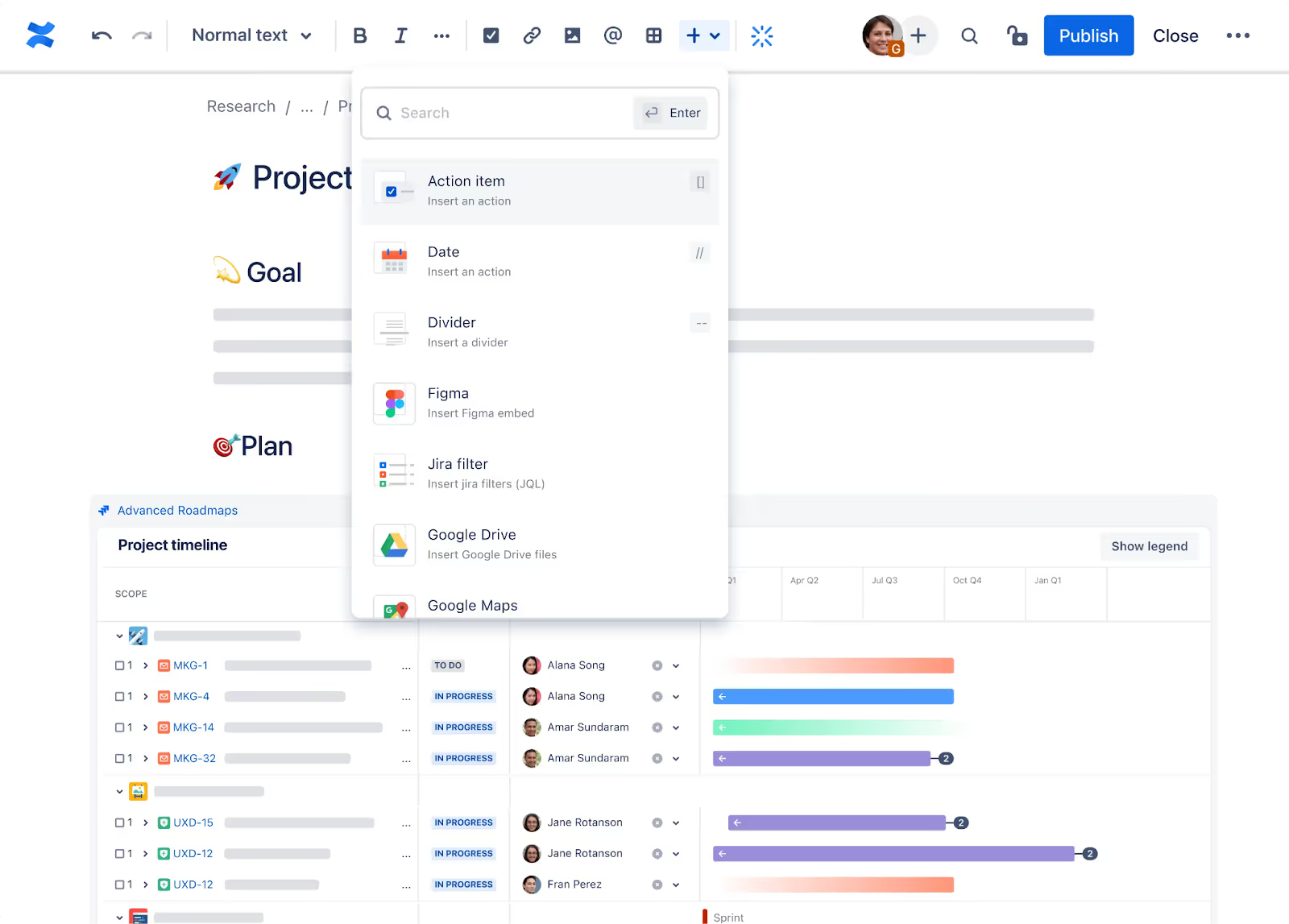
Key Features:
- Whiteboard feature with built-in Jira integrations for team brainstorming and collaboration
- Pages for editing, creating, and discussing the team’s work
- Knowledge base with advanced search and content tree
- Page versioning for tracking document history and comparing versions
3. Google Drive

Google Drive is one of the more popular cloud storage content management platforms. It is designed to provide users with simple file storage and sharing functionalities and integrates with Google Docs, Sheets, and Slides for content creation and storage. However, like Microsoft SharePoint, Google Drive is not a niche app designed for sales, so users don’t get anything more than secure file storage and sharing.
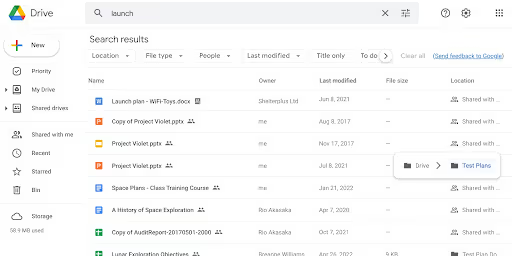
Key Features:
- Integration with Google Docs, Google Slides, and Google Sheets for content creation
- AI-powered search functionality
- Access to other products in the Google Workspace, such as Gmail, Meet, and Google Calendar
- Up to 2TB content storage (paid)
4. Dropbox Business
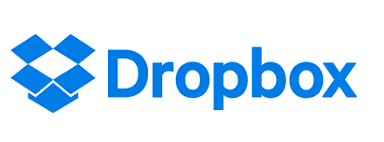
Dropbox Business is a content management platform that allows users to store and share large amounts of data. It has features to protect documents and track changes to them, including version history, to give users access to different versions of each document. Dropbox Business also provides some content analytics, since users can share documents with others and track how the recipients interact with the documents.

Key Features:
- Up to 15 TB content storage
- Content protection features such as password protection, file recovery, watermarking, and viewer history
- Trackable links for real-time documents analytics
- eSignature templates for contracts
5. Zoho Workdrive

Zoho Workdrive is a content management platform that gives teams a unified virtual workplace. It supports role-based access to limit team members' access to documents to only what they need. WorkDrive supports preview for over 200 file formats, so you can always preview files without opening or downloading them. Zoho WorkDrive also has searchability features so you can find documents when you need them, including scanned documents and images with an OCR feature.
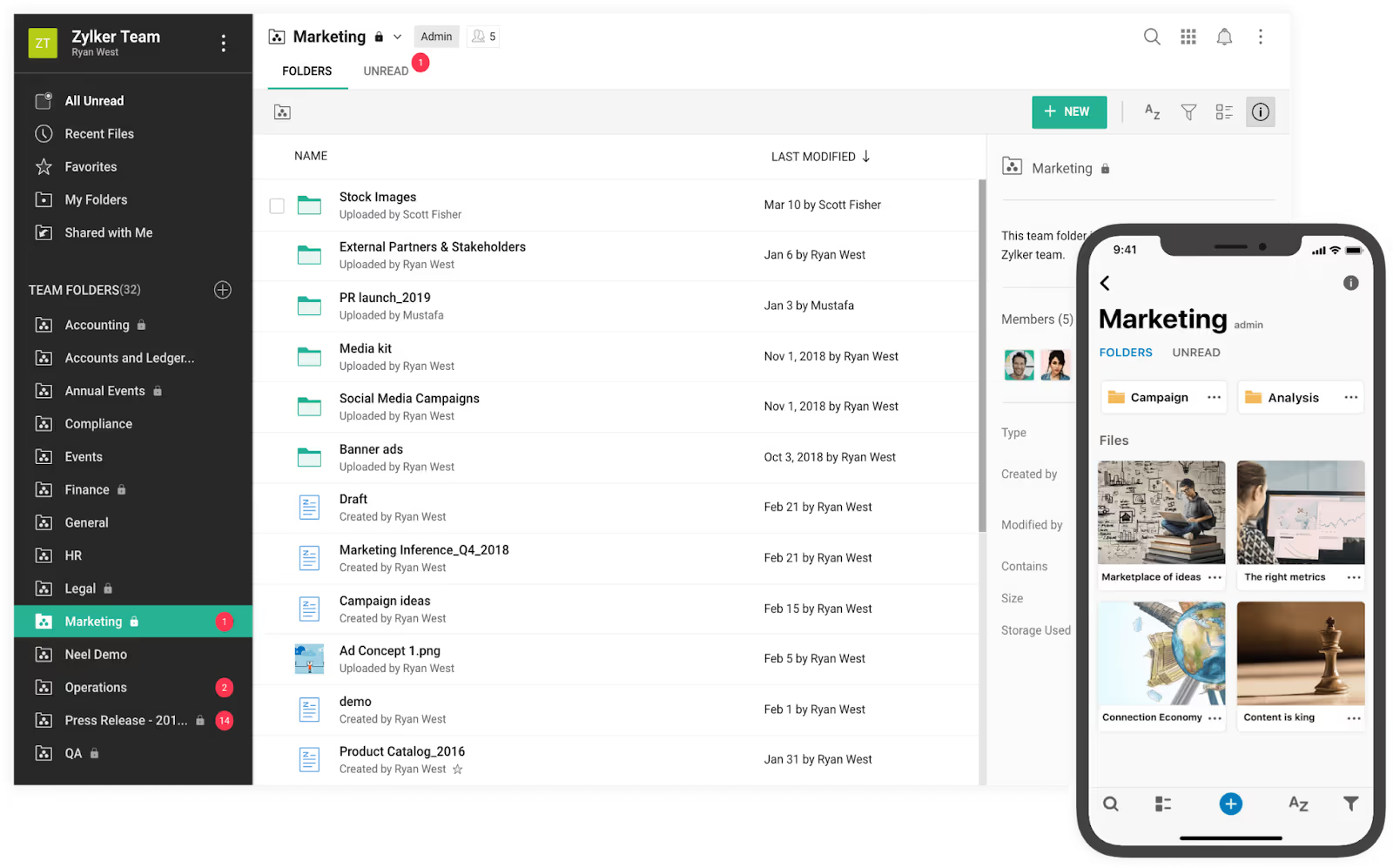
Key Features:
- Role-based access control for document security
- OCR and object detection features are enabled for image searchability
- Integration with Zoho Chat, Zoho Sheet, Zoho Show, and Zoho Writer
- Analytics to view who made changes to documents
Use the Best Sharepoint Alternative
SharePoint can be a solid platform for digital content storage, but for sales teams looking for fast content creation and content accessibility, it’s not going to be the best fit.
If you want a niche sales collateral management platform that focuses on salespeople, works within the apps your sales teams use, and has the tools and features to enhance your sales performance, then you should try Spekit.
Spekit’s sales enablement solution integrates with your existing processes rather than the other way around. The platform doesn’t require you to change your existing sales methodology, so whether you are using MEDDIC sales methodology or another methodology.
With Spekit, reps don’t need to go through several folders to find the sales information they need. They can just use Spek and sit back while the exact information they need is surfaced right in the app they are using.Empower your sales team with the right collateral management platform they need to exceed their targets.

